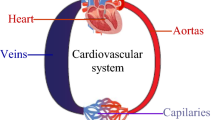Abstract
The uptake of the drugs by human organisms has long been one of the primary concerns of pharmacological research. The numerical model of the human cardiovascular and respiratory system with the baroreflex and chemoreflex regulation including the physiologically-based pharmacokinetic model and also the model of the drug-cardiac cell channels interaction is developed at the IT CAS. The 24th segments model of pulsating type imitating the electrochemical and mechanical activity of heart muscle was used to the simulation of the antiarrhythmic drug (propranolol) effects on the themodynamic and physiologically behaviour of these systems.
Similar content being viewed by others
References
Beeler GW, and Reuter H. Reconstruction of the action potential of ventricular myocardial fibres. J Physiol (Lond.) 268: 177–210, 1977.
Duffin J, et al. A model of the chemoreflex control of breathing in humans: Model parameters measurement. Respir Physiol 120: 13–26, 2000.
Khoo MC, and Yamashiro SM. Models of control of breathing. In Chang HA, and Paiva M, Eds, Respiratory Physiology: An analytical approach, New York: Marcel Dekker, 1989, pp. 799–825.
Levitt DG. PK Quest: A general physiologically based pharmacokinetic model. Introduction and application to propranolol. BMC Clinical Pharmacology 2002, 2:5. http://www.biomedcentral.com/1472–6904/2/5.
Maršik F, Převorovská Š, and Stembera V. The influence of compliance and resistance of arteries on Korotkoff sound generation in numerical modelling. Acta Bioengineering and Biomechanics 4(Supplement 1): 716–717, 2002.
Převorovská S, Maršik F, and Musil J Pressure generation by chemical reactionin the human cardiovascular system. Engineering Mechanics 4(3): 147–580, 1997.
Převorovská S, Musil J, and Maršik F. Human cardiovascular system with heart failure under baroreoex control (numerical model). Acta Bioengineering and Biomechanics 3(I): 39–52, 2001.
Seidel H, and Herzel A. Modeling Heart Rate Variability due to Respiration and BaroreOcx. In Mosekilde E, and Mouritsen OG, Eds, Modeling the Dynamics of Biological Systems, Springer-Verlag, Berlin, 1995, pp. 205–229.
Starmer CF. How antiarrhythmic drugs increase the rate of sudden cardiac death. International Journal of Bifurcation and Chaos 12(9): 1953–1968, 2002.
Author information
Authors and Affiliations
Corresponding author
Rights and permissions
About this article
Cite this article
Pěevorovská, S., Maršík, F. Numerical Simulation of Hemodynamic and Physiological Responses of Human Cardiovascular and Respiratory System under Drugs Administration. Cardiovasc Eng 4, 295–304 (2004). https://doi.org/10.1007/s00270-005-8755-6
Issue Date:
DOI: https://doi.org/10.1007/s00270-005-8755-6




